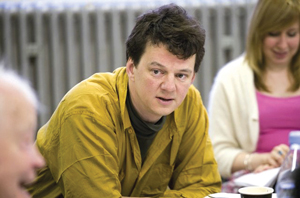Dodgy seats, wobbly sightlines and a controversial closure have given the Bristol Old Vic plenty of trouble in the past, but its prospects are looking up with Tom Morris at the helm. He talks to Eleanor Turney about his plans for the theatre’s future.

Tom Morris reminds me of a proud parent. He counts the ways in which he adores the Bristol Old Vic (BOV), asserts that it is “the most extraordinary theatre in the country”, and eulogises about his hopes for its future. Just as one would be loathe to tell a new dad that his baby is anything less than exquisite, I refrain from mentioning the shabbiness of the auditorium, the bum-achingly uncomfortable seats, the poor sightlines. It was once a beautiful theatre, and I’m convinced (partly by Morris’s enthusiasm and partly by Arts Council England’s (ACE) £5.3m cash injection) that it will be again, but at the moment it leaves something to be desired as a space to watch a show.
BUILDING EXCELLENCE
“The kind of theatre that I like is theatre that celebrates the presence of the audiences, rather than pretending or wishing they weren’t there,” says Morris. This can only be a good (if slightly obvious) thing for an artistic director to think – after all, audiences mean tickets which in turn, mean money, something the BOV is sorely in need of. Morris’s beloved auditorium is, he says, “ripe for that kind of programming” as he believes it is a “uniquely intimate, interactive theatre”. Unique it may be, but I can’t help thinking that’s a good thing, given how uncomfortable the experience of watching a show there can be. As a former associate director at the National Theatre, probably best-known for his success with ‘War Horse’, Morris is not unfamiliar with the challenges of unusual staging. He dismisses criticism that the BOV’s auditorium is flawed, suggesting that “if you engage with the auditorium in ways that are influenced by its original design… and if you think intelligently about the sightlines and how to improve people’s comfort and how to engage with the playing area, you end up with something that is a really exciting place for a theatrical project to meet an audience”.
ACE has put its money where its faith is by granting the theatre a large contribution towards its restoration, which will go some way towards fulfilling Morris’s vision of returning the theatre to “architectural principles that are much closer to an Elizabethan theatre than Victorian”. Again, it seems churlish to quibble with him when he is trying to take an intelligent approach, but Elizabethan audiences were rather different to theatregoers today, who expect a seat where they can see and hear the action. The space may be a marvellous one for a theatrical project to meet an audience, but it’s not such a great place for the audience to meet the project: a good third of the stage is invisible unless one sits dead centre, and the seats lurch enough to cause seasickness, distracting from the action on stage. Perhaps this will just set the theatrical bar very high – if the performances are good enough the backache will be forgiven, if not forgotten.
COMMUNITY SPIRIT
Morris, who took over artistic management of the theatre just over a year ago, is nothing if not enthusiastic (he uses the word “exciting” a lot during the course of our chat), and animated about the BOV’s possibilities. He is, for obvious reasons, keen to look to the future and put the building’s “period of inactivity” (when the theatre suddenly went dark for 18 months, many staff lost their jobs, and renovation costs crept up from an estimated £7m to £9m) behind him. Although he does not criticise his predecessors, he does admit that “the [previous] operating model for the theatre had not worked for some time”. However, he has big plans, beginning with “re-engaging [Bristol]”, a city which he describes as “very culturally active and potentially very, very culturally fruitful”. He also emphasises his ambition to restore the theatre to its former glory – both architecturally and artistically.
Bristol may well be the place to do that. Morris often returns to the importance of the city and its residents. He would like to position the BOV as a responsive site, one that allows the city’s creative community to come up with ideas that might turn into pieces of theatre. “There has been a slight shift away from thinking of theatre simply as a product to be put in a shop (or a theatre) and sold,” he explains, keen to emphasise the idea that theatre should exist as part of an ongoing debate with artists.
Morris also acknowledges that ticket prices are a substantial obstacle to the casual but curious theatregoer (echoing findings from the most recent Society of London Theatre report [AP215]), curiously referring to the BOV’s £5 tickets as “an invitation” rather than an audience development initiative. His commitment to programme theatre that lures in new audiences is another high priority, he wants “work that doesn’t seem alien to non-theatregoers”. Morris has no shortage of experience and creative ideas. As he reels off the triumphs of the city’s assorted cultural venues, it is easy to be convinced of his fondness for the area. More than that, it is reassuring to come away feeling that, finally, the Bristol Old Vic is in a safe pair of hands.
Join the Discussion
You must be logged in to post a comment.